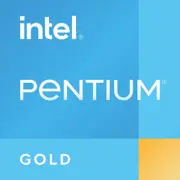Intel Pentium Gold G5500T

Intel Pentium Gold G5500T: Processore budget per compiti di base (aprile 2025)
Caratteristiche principali: Architettura Coffee Lake in formato compatto
Il processore Intel Pentium Gold G5500T, rilasciato nel 2018, rimane una soluzione budget popolare grazie all'equilibrio tra prezzo ed efficienza energetica.
- Architettura: Coffee Lake (14 nm). Nonostante il processo produttivo obsoleto, il chip è ottimizzato per un basso consumo energetico.
- Nuclei e thread: 2 nuclei / 4 thread (Hyper-Threading). Frequenza base — 3.2 GHz (modalità turbo assente).
- Cache: L3 — 4 MB. Sufficiente per applicazioni semplici, ma limitato per compiti complessi.
- Grafica: Intel UHD Graphics 630 (frequenza base — 350 MHz, massima — 1.05 GHz). Supporta 4K@60 Hz tramite HDMI/DisplayPort.
- TDP: 35 W. Ideale per sistemi compatti senza raffreddamento attivo.
Caratteristiche chiave:
- Supporto per la tecnologia Intel Quick Sync Video per la codifica video veloce.
- Compatibilità con Windows 11 (richiede l'attivazione di TPM 2.0 sulla scheda madre).
- Prezzo basso: il nuovo processore può essere trovato per $50–60 (anno 2025).
Schede madri compatibili: Socket LGA 1151 v2 e considerazioni sulla scelta
Il G5500T utilizza lo socket LGA 1151 v2, ma richiede chipset della serie 300:
- H310/B365: Schede madri economiche (ASRock H310CM-HDV, ~$60). Adatte per PC da ufficio, ma limitate per l'overclock della memoria.
- H370/Z390: Schede madri con supporto USB 3.1 Gen2 e PCIe 3.0 x16 (ad esempio, MSI Z390-A PRO, ~$120).
Importante:
- Le schede madri con chipset H310/B360 potrebbero richiedere un aggiornamento del BIOS per funzionare con Coffee Lake.
- Evitate le schede madri delle serie 100/200 (ad esempio, H270) — non sono compatibili.
Memoria supportata: DDR4 e ottimizzazione
Il processore funziona con DDR4:
- Ufficialmente: fino a 2400 MHz (con chipset H310/B365).
- Overclock: Su Z370/Z390 è possibile attivare i profili XMP per 2666–3000 MHz.
Raccomandazioni:
- Utilizzate una configurazione dual-channel (2×8 GB DDR4-2400) — questo aumenterà le prestazioni della grafica integrata del 15–20%.
- Per compiti d'ufficio, 8 GB sono sufficienti, per multimedia — 16 GB.
Alimentatore: Massimo risparmio
Considerando un TDP di 35 W e l'assenza di schede grafiche discrete:
- Scenario base: Alimentatore da 300 W (ad esempio, EVGA 300W, ~$40).
- Con riserva: Se si prevede di installare una GPU di livello GTX 1650, scegliere un alimentatore da 450 W (Corsair CX450, ~$65).
Consiglio: Anche per una costruzione economica, optate per alimentatori con certificazione 80 Plus Bronze — sono più affidabili e risparmiano energia.
Pro e contro del Pentium Gold G5500T
Pro:
- Efficienza energetica: Un PC con questo processore può essere assemblato in un case delle dimensioni di un libro.
- Grafica integrata: UHD 630 gestisce video 4K e giochi datati (ad esempio, GTA V a impostazioni basse — 25–30 FPS).
- Prezzo: Tra i più bassi sul mercato (più economico del Ryzen 3 2200G).
Contro:
- Solo 2 nuclei: Nel 2025, questo è insufficiente per il multi-tasking (streaming + giochi) o per le applicazioni moderne ottimizzate per 4+ nuclei.
- Mancanza di supporto PCIe 4.0/5.0: La velocità degli SSD NVMe è limitata.
Scenari d'uso: Per chi è rilevante il G5500T?
1. PC da ufficio: Lavoro con documenti, browser, Zoom. Esempio: una costruzione con G5500T + 8 GB DDR4 + SSD 256 GB costerà circa ~$200.
2. Media center: Riproduzione di contenuti 4K tramite Plex o Kodi.
3. Giochi leggeri: Minecraft, CS:GO, Dota 2 (fino a 60 FPS a impostazioni basse).
4. Progetti educativi: PC per scuole o apprendimento domestico.
Limitazioni: Non adatto per il montaggio video in DaVinci Resolve, modellazione 3D o l'esecuzione di Cyberpunk 2077.
Confronto con i concorrenti
- AMD Athlon 3000G (2C/4T, Vega 3): Più economico (~$45), ma più debole in compiti a singolo thread. UHD 630 è più veloce di Vega 3 del 10–15%.
- Intel Core i3-9100 (4C/4T): Per $80–90 offre 4 nuclei, che sono critici per il multi-tasking.
- Ryzen 3 3200G (4C/4T, Vega 8): Più potente nei giochi (~$70), ma richiede una scheda madre più costosa (AM4).
Conclusione: G5500T vince solo in prezzo ed efficienza energetica.
Consigli per l'assemblaggio
1. Case: Scegliete Mini-ITX (Fractal Design Node 202) o soluzioni compatte.
2. Raffreddamento: Il dissipatore standard è sufficiente, ma per maggiore silenziosità sostituitelo con un Noctua NH-L9i (~$45).
3. Storage: Assicuratevi di avere un SSD (Kingston A400 480 GB, ~$35) — un HDD “strozzerebbe” anche questo processore.
4. Aggiornamenti: Non investite in schede madri costose — il G5500T diventerà un "collo di bottiglia" per le GPU moderne.
Conclusione finale: Per chi è adatto il G5500T?
Questo processore è una scelta per chi:
- Costruisce un PC economico per internet, film o studio.
- Necessita di un sistema compatto (ad esempio, HTPC).
- Non prevede di eseguire programmi o giochi “pesanti”.
Alternativa: Se il budget permette di aggiungere $20–30, è meglio optare per un Ryzen 3 3200G o un Core i5 di ottava generazione usato — offriranno maggiori possibilità di aggiornamento futuro.
Il Pentium Gold G5500T non è il più potente, ma è uno dei processori più accessibili del 2025. Va considerato solo in scenari ultra-budget, dove ogni $10 conta.
Di base
Specifiche della CPU
Specifiche della memoria
Specifiche della GPU
Varie
Classifiche
Rispetto ad altre CPU
Condividi sui social media
Oppure linkaci
<a href="https://cputronic.com/it/cpu/intel-pentium-gold-g5500t" target="_blank">Intel Pentium Gold G5500T</a>